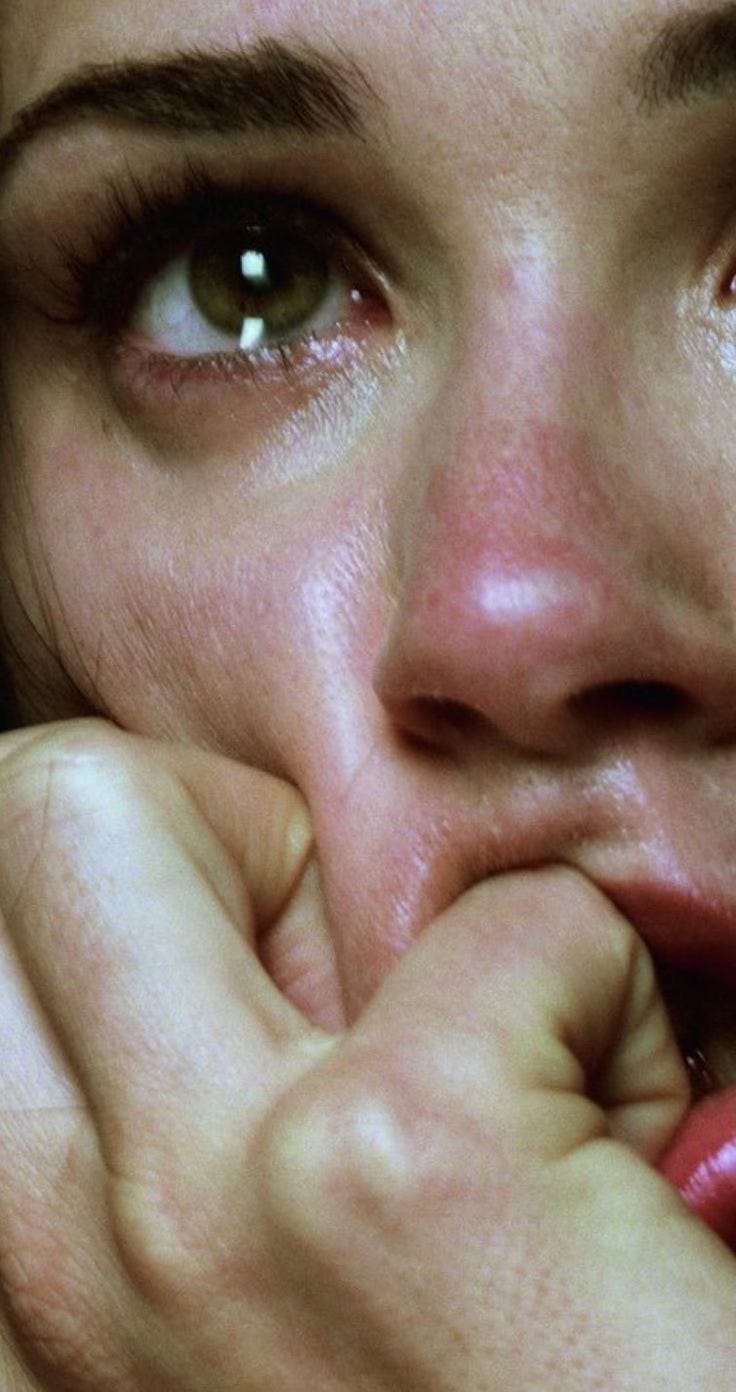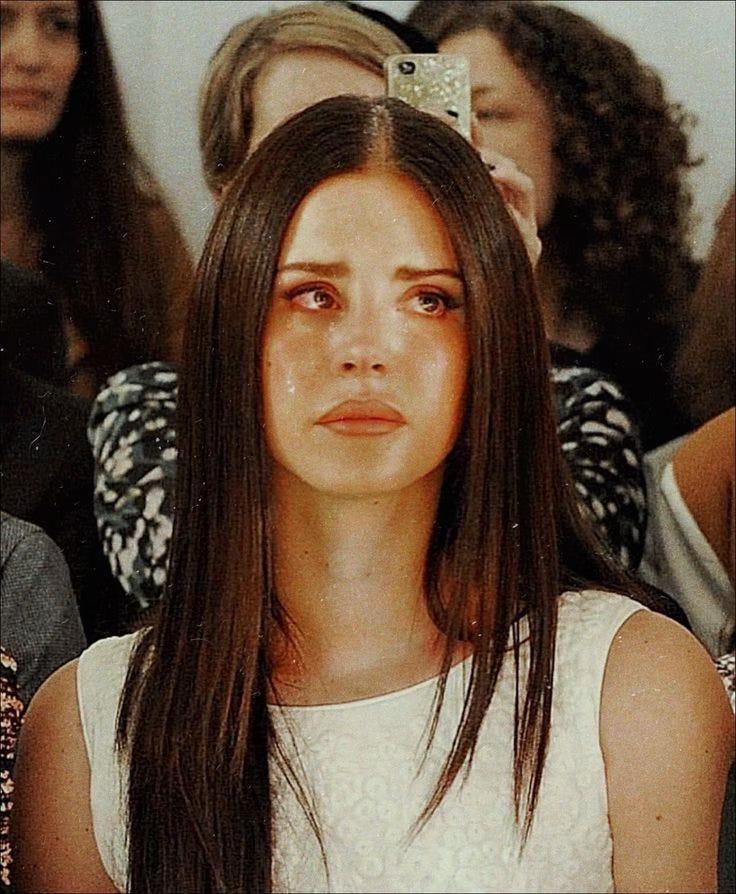1.
My iPhone doesn’t recognize me when I cry. If I’m sobbing and try to unlock my phone with Face ID, I can’t get in without using the passkey. I assume I’m too unrecognizable with a vaguely contorted face; even actively smoothing out my expression does nothing to improve the identification. Something about being too sad causes the phone to push me away.
Go away and try again when you’re feeling better, it says. We don’t want you and your misery.
And so I put down the phone.
2.
A scene in HBO’s “Succession” ended up on the cutting-room floor, but I found it while reading the tomes of scripts I recently acquired from Waterstones: one of the Roy children talks about the “ugly mirror.” According to them, their mother Caroline would make them look into it whenever they cried so that they could see “how ugly [they] looked” and, ostensibly, be so embarrassed by the sight of their crying faces that they’d stop.
It seems like a cruel tactic—we also know that Lady Caroline Collingwood is not exactly a terrific mother—but I’ve seen a lot of parents use a similar technique on their children. I’ve often witnessed mothers publicly shaming their children for crying, usually by indicating that they’re being witnessed by other people.
You don’t want that boy over there to see you crying, do you?
Or, You don’t want that auntie over there to watch you cry, right?
I saw this particular at dinners when my extended family gathered at restaurants, and I wasn’t yet old enough to engage in the conversations to be had by the adults. I watched parents at other tables trying to wrangle their small, shrieking children by pointing at someone at our table and telling them that we, these strangers, were watching and judging their tears. I didn’t like being implicated in these schemes to keep various children quiet, but my mere existence was enough, sometimes, to get them to stop.
I’ve often witnessed mothers publicly shaming their children for crying, usually by indicating that they’re being witnessed by other people. You don’t want that boy over there to see you crying, do you? Or, You don’t want that auntie over there to watch you cry, right?
After years of crying quite a lot about almost everything, some combination of medications that I began taking caused me to cry quite seldom. I didn’t feel bottled up, or like I was dead behind the eyes. I just didn’t feel like crying. It’s only been recently that I’ve been crying again.
I find that I cry buckets in the few days before my period begins. My body signals the oncoming blood by telling me that everything in the world is so moving, so sad, so overwhelming. Why wouldn’t we all be crying all the time, given what’s happening?
3.
Let’s think about another population of criers: the women on Instagram who document their tears in photographs or Reels, superimposing text over the video or still image, explaining—but not too much because you won’t otherwise be tempted to click through—what, exactly, has made them so desperately unhappy. Often, these women are in cars, in parking lots. Some of them have had miscarriages and are chronicling their experience outside of the doctor’s office. Some of them are overwhelmed by caring for their children. Whatever the reason, they’ve felt compelled to shoot themselves weeping, and to put the evidence online.
I’ve also noticed that such posts tend to receive more angry comments than sympathetic ones.
“I don’t know what the fuck is wrong with some people that they’d feel the need to post stuff like this.”
“Is nothing private anymore?”
“Attention whore.”
It’s this last one that really makes me laugh. Aren’t we all attention seekers on social media? Why else are you there in the first place, even if your particular desire isn’t to show yourself in the state of écorhé vif?
I also wonder what the primary purpose of social media crying is, particularly when wielded by the very shade and gender of human beings whose tears are usually seen as particularly sympathetic and, at worst, easily weaponized. I’m not saying that these women are not actually sad, or that they’re not, indeed, suffering. There might not be someone in their IRL lives who can give them the condolences they want. By making their tears so public, they’re casting a wider net of potential sympathy, even if many of the comments are of the variety of a Victorian scold.
Still, a Victorian scold would likely approve of the aesthetics in these performances; if you have to make your tears public, you might as well make them beautiful. These women, upset as they are, are never “ugly criers.” The tears emerge from their eyes slowly, poetically cascading in rivers down their pale, pretty faces. There’s no deep, disgusting inhale of snot, or the back of a hand smearing across their nostrils, pulling away with a booger clinging to the skin. We might be interested in seeing women cry on social media, but the women who make the recordings are aware of being watched. Any trails of mascara should be artful. The eyes can cry, but they can’t be too swollen. As with anything else on social media, the vision is carefully curated.
(Authenticity is the watchword on social media, but there remain limits.)
The model Bella Hadid posted about her struggles with anxiety alongside a series of crying selfies. She writes:
This is pretty much my everyday, every night, for a few years now. Social media is not real. For anyone struggling, please remember that. Sometimes all you’ve gotta hear is that you’re not alone. So from me to you, you’re not alone. I love you, I see you, and I hear you.
But. I mean. It’s still Bella Hadid, who is so known for her impact on fashion labels that there exists a phrase called The Bella Effect. She is young, with her reputation placing her beyond even most models. As for her teary selfies: a million people liked her post in less than 24 hours. I’m fascinated by using this particular act to “raise awareness” about anxiety and depression. A young, beautiful model posts pictures of herself crying to indicate that her life is not perfect—which is to say that I don’t doubt one bit that she suffers from mental health issues. What I marvel at is that an Instagram-oriented society is able to applaud this type of proof because she is beautiful, white-passing, and able to demonstrate her sadness in a way that gains approval.
We might be interested in seeing women cry on social media, but the women who make the recordings are aware of being watched, and, therefore, want to be careful about how they appear. Trails of mascara should be artful. The eyes can cry, but they can’t be too swollen. As with anything else on social media, the vision is carefully curated.
4.
I’ve never lived in New York City, but I’ve heard again and again that it’s a perfect place to cry in public. By “a perfect place to cry in public,” as far as I can tell, people mean that you can cry in as ugly a manner as you wish, and no one will stare at you or interfere with your nervous breakdown. Because of a certain invisibility to one another, no one will embarrass you by trying to make you feel better. Everyone’s done it—apparently, New York City just makes people cry, so everyone will leave you and your meltdown in peace. You won’t have to worry about waving them off—smiling—saying, “No, no, I’m really okay” when you’re not.
According to a 2013 paper by Martijn, et. al, a series of experiments seemed to indicate that the presence of tears was more likely to bring about social sympathy and, thus, support—regardless of the actual facial expression. Simultaneously, context is essential to the actual elicitation of social help. Most children will tell you that being witnessed crying by their peers can bring about bullying and ridicule. The mothers that I witnessed chiding their children in public while I was growing up spoke to a fear that their kids already had.
San Francisco, where I live, doesn’t have a reputation for being A Great Place to Cry. Yet one of the kindest things a stranger has ever done for me was when a security guard in my HMO’s Psychiatry department stopped and asked if I was okay when I was blubbering on my way to the elevators. Maybe some people don’t want that kind of attention, but I’m not attracted to the idea that an entire city is known for ignoring the emotions around them. I still think of that security guard as an angel, and I hope he’s living well—wherever he is by now.
5.
The last photograph that I took of myself crying was from this February, on the day I learned that C had high-risk bone marrow cancer. I waited for him to leave for work, and then I cried for five hours straight, causing my face to become swollen and miserable; I took a photo for posterity. In the photograph, my eyes are red and swollen. My face is slick. I thought about posting the photograph here, but decided I’d rather not; it’s an important memory, even a bad one, that I can choose to keep for me, and for me alone.
One more thing: I wanted to share an interview with me that Jane Ratcliffe, the wonderful woman behind the newsletter Beyond, recently published. She’s been kind enough to take down the paywall for the interview so that Unexpected Shape readers can read it. Read the interview and consider subscribing here: Taking Clouds and Putting Them In A Jar: A Conversation with Esmé Weijun Wang.










The most beautiful response to public crying came one day when I was about three days into an horrific break up. I was crying for more than the relationship, the person I had really lost was myself, and I just couldn’t stop.
I’d been staying with my bestie and she cajoled me out of the house to sit on the beach while she and her family went to a market.
I was crying, still crying, truly not caring who saw.
Two teenage girls walked past and asked if I was okay. I nodded, barely able to speak, and they gave me a sympathetic look.
About twenty minutes later they walked by me again, and handed me a small posy of hand-picked flowers. ‘I hope things get better,’ one of them said.
I’m crying as I recall this, this beautiful moment of being witnessed and held and not asked to change to make them feel comfortable. The small gesture, the words of hope.
In that moment I felt less alone, and I feel it now too.
Thank you for the reminder. ❤️
When was the last time you cried?